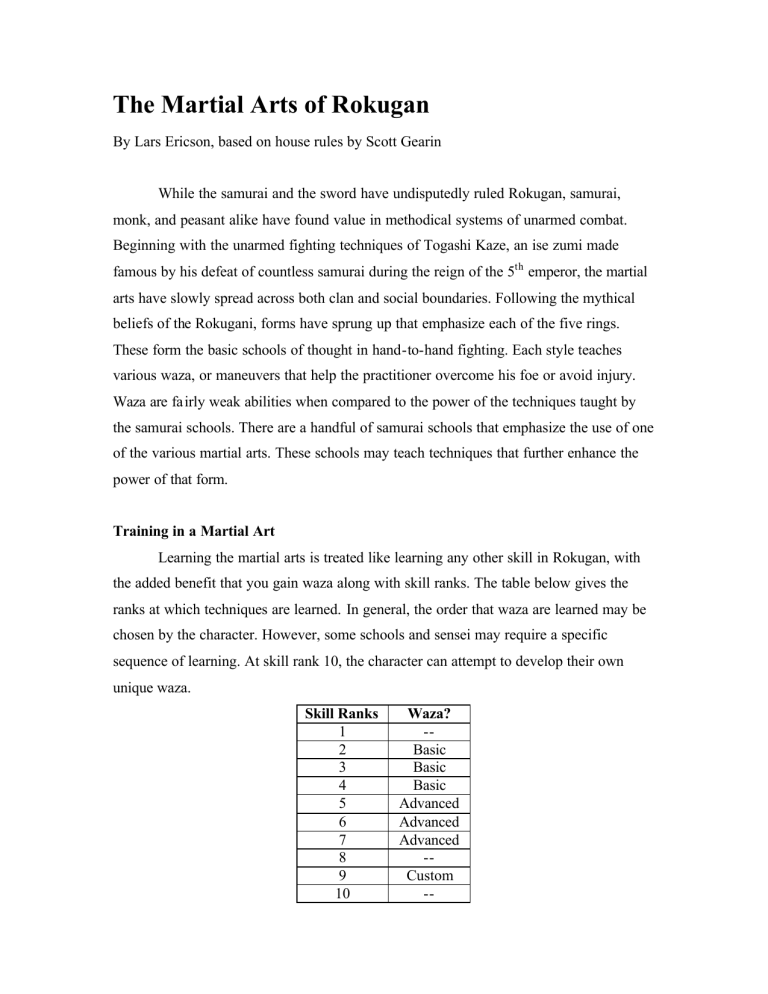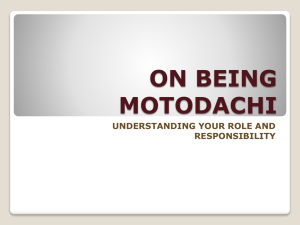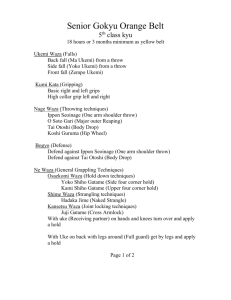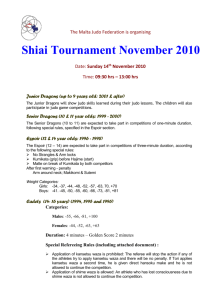
The Martial Arts of Rokugan By Lars Ericson, based on house rules by Scott Gearin While the samurai and the sword have undisputedly ruled Rokugan, samurai, monk, and peasant alike have found value in methodical systems of unarmed combat. Beginning with the unarmed fighting techniques of Togashi Kaze, an ise zumi made famous by his defeat of countless samurai during the reign of the 5th emperor, the martial arts have slowly spread across both clan and social boundaries. Following the mythical beliefs of the Rokugani, forms have sprung up that emphasize each of the five rings. These form the basic schools of thought in hand-to-hand fighting. Each style teaches various waza, or maneuvers that help the practitioner overcome his foe or avoid injury. Waza are fairly weak abilities when compared to the power of the techniques taught by the samurai schools. There are a handful of samurai schools that emphasize the use of one of the various martial arts. These schools may teach techniques that further enhance the power of that form. Training in a Martial Art Learning the martial arts is treated like learning any other skill in Rokugan, with the added benefit that you gain waza along with skill ranks. The table below gives the ranks at which techniques are learned. In general, the order that waza are learned may be chosen by the character. However, some schools and sensei may require a specific sequence of learning. At skill rank 10, the character can attempt to develop their own unique waza. Skill Ranks 1 2 3 4 5 6 7 8 9 10 Waza? -Basic Basic Basic Advanced Advanced Advanced -Custom -- Learning Multiple Arts A character may learn multiple martial arts. In general, they should be considered separate skills and their respective waza should be considered separate For example, kaze-do’s Sweeping & Throwing is not the same as mizu-do’s Sweeping & Throwing waza since they teach different philosophies, movements, and actions to accomplish the same goal. A character is considered using a specific HTH skill once he declared an action. However, if a character has mastered all of the basic waza of a style (i.e. at least skill rank 5), then they have sufficient experience and knowledge to incorporate the teachings of a second (and even third) style. When performing a waza which is known by the character under two different styles, the character gains an additional die to their HTH skill for every 3 full levels of additional styles. Setsuka has mastered all of the basic waza of mizu-do and currently has rank 5. He has also been slowly learning kaze-do from a Dragon comrade. Upon reaching kazedo rank 3, he learns Kaze-do Sweeping & Throwing. Because of this new knowledge and his experience in mizu-do, when Setsuka performs a Mizu-do Sweeping & Throwing he may now roll 6 dice, incorporating some of the teachings of kaze-do. Attacking with Martial Arts All five styles teach minor maneuvers and attacks in addition to their core waza. All such standard attacks use (Martial Art)/Agility and inflict (Str) + 0k1 damage. Samurai armor and monster carapaces both provide an additional +5 difficulty to-be-hit against such attacks. Armor and carapaces do not provide any benefit against waza unless specified. Kaze-do The martial art of Air created by Togashi Kaze is swift and precise, with an emphasis on defeating the armed opponent. Kaze used it to teach humility to many a samurai, and refused to demonstrate it before the emperor, even though it cost him his life. Today only peasants and monks know this art outside the Dragon Clan; samurai must be of the Dragon Clan to be taught kaze-do. Kaze-do is a Bugei skill. Basic Waza Empty the Hand Grappling Sweeping & Throwing Advanced Waza Breakfall Nerve Strike Wind Walk Mizu-do The martial art of Water stresses non- violence and active patience. Force seeks force blindly, and meeting violence with more violence is the most passive of all possible responses. By actively being aware of the nature of conflict, one can resolve it swiftly without escalating it. Mizu-do has its origins as a martial art developed by Crane artisans in order to show realistic fighting in their dramatic performances. Mizu-do has become a Crane tradition, used by artisans and courtier to defend themselves in dangerous circumstances. Samurai must be of the Crane Clan to be taught mizu-do. Mizu-do is a High skill. Basic Waza Breakfall Receiving the Gift Sweeping & Throwing Advanced Waza Bend Like a Reed Empty the Hand Grip of the Crane Tsuchi-do The martial art of Earth is the creation of Hiruma Teji, and like many Crab arts is focused on endurance. Practitioners train to become solid, the bedrock which the empire rests upon. Being both a Crab and a samurai art, it is more pragmatic than graceful, and more efficient than compassionate. Crab bushi may substitute tsuchi-do for jiujutsu if it is one of their starting school skills. Samurai must be of the Crab Clan to be taught tsuchido. Tsuchi-do is a Bugei skill. Basic Waza Root the Mountain Shove Grapple Advanced Waza Harsh Blow Receiving the Gift Armor of Earth Hitsu-do The martial art of Fire is a fast and deceptive art that relies on placing oneself in positions that others would think too dangerous in the pursuit of one’s goals. In one of the more unusual partnerships in Rokugan’s history, both the Scorpion and the Phoenix have had a hand in the development and refinement of this art. Shiba Reiko, a Phoenix samurai with Scorpion heritage, originated the art. She recognized the two clans’ common belief in sacrificing everything for duty. Samurai must be of the Scorpion or Phoenix clan to be taught hitsu-do. Hitsu-do is a Bugei skill. Basic Waza Bend Like a Reed Nerve Strike Harsh Blow Advanced Waza Root the Mountain Grapple Sacrificial Throw Jiujutsu Many attribute jiujutsu to the first Ikoma, a vicious, relentless fighter who would never allow the mere lack of a weapon to halt his assault. Jiujutsu embodies the essence of bushido – defense of the empire at all costs. A warrior is defined by his honor and resolve, not the katana in his hand. Jiuj utsu is the most common of the arts practiced by samurai, and can be found in many dojo and all major and minor clans. Basic Waza Harsh Blow Grappling Root the Mountain Advanced Waza Breakfall Shove Stone Fist Waza In all descriptions of waza, “HTH” refers to the martial art being used. “PG” refers to the L5R 2nd ed. Player’s Guide and “GMG” refers to the L5R 2nd ed. Game Master’s Guide. Armor of Earth: The tsuchidoka has become as solid and eternal as the earth itself. The warrior has a Carapace rating equal to his tsuchi-do skill against all HTH attacks and waza. This means that every damage die that rolls below the martial artist’s HTH skill rank is reduced to “1.” This waza is instinctual and therefore always in effect. Bend Like a Reed (as PG, p. 182): The martial artist focuses on escaping a direct attack from a single opponent. The practitioner rolls HTH/Reflexes with a TN of five times the opponent’s weapon skill. If successful, the opponent’s strike misses. Unless used in conjunction with Receiving the Gift, this waza requires knowledge of an impending attack, and therefore can only be used against opponents with a lower initiative score for that round. Breakfall. The martial artist is considered to have a Carapace rating (GMG, p. 139) equal to his HTH skill when taking damage from falls, sweeps, and throws. This means that every damage die that rolls below the martial artist’s HTH skill rank is reduced to “1.” This waza is instinctual and therefore always in effect. Empty the Hand: The practitioner gains two free raises when attempting to disarm an opponent with his martial art (the attempt only requires one raise instead of three). The disarming character and her target make a Contested Roll using their respective weapon skills and their Agility. If the disarming character wins the Contested Roll by the required one Raise (i.e. 5), she successfully disarms her opponent. Grappling (as PG, p. 181): The attacker attempts to grab his enemy, slamming them into the surroundings, landing close strikes, and choking them. It is close in fighting. The grappling character makes a HTH/Agility roll vs. his opponent’s Agility x 5. If the roll succeeds, the grappler does (Strength)k1 Wounds, as usual. He will continue to inflict Wounds until the grappled character frees himself. To free himself, the grappled character must take an Action and make a Contested Roll against the attacker. Both use HTH/Agility or HTH/Strength. Samurai and monster carapaces provide normal protection, but not the additional +5 penalty. Harsh Blow: The martial artist's standard attacks receive a free raise for damage (+1k0 damage). Grip of the Crane (Dragon Claw, PG p. 182): This waza is an incapacitating nerve hold. It requires a successful Mizu-do/Agility roll versus the attacking opponent’s Agility x 5. The mizudoka grabs one of the attacker’s limbs and twists it while applying pressure it his nerve centers. By using Raises, the mizudoka can inflict non- lethal Wounds in addition to securing a hold. This damage is calculated by rolling a number of dice equal to the number of Raises plus the mizudoka’s Strength, keeping a number of dice equal to the number of Raises. This damage vanishes after ten minutes. Additional Raises may either increase the non- lethal damage (as described above) or add 10 minutes to the duration of the Wounds. A character cannot fall below “Out” from this maneuver. Also, because the need to reach vital nerve locations, penalties from the opponent’s armor are applicable as is the additional +5 penalty. The mizudoka may choose to continue to inflict non- lethal damage in subsequent rounds. The opponent may attempt to break free by winning a contested Agility roll against the mizudoka. Failing this test, inflicts 1k1 damage in addition to any other damage received this round from this waza. Nerve Strike: This waza teaches how to strike at vital locations with quick piercing attacks so as to temporarily incapacitate their opponent. The martial artist makes a HTH/Agility roll against the target’s normal TN to be hit. The waza inflicts (Strength)k1 non- lethal damage that vanishes after ten minutes. Additional Raises may either add 1k0 non- lethal damage or add 10 minutes to the duration of the wounds. A character cannot fall below “Out” from this maneuver. Also, because the need to reach vital nerve locations, penalties from the opponent’s armor are applicable as is the additional +5 penalty. Alternatively, by making 2 Raises, the martial artist can target a specific limb (arm or leg). By inflicting a number of Wounds equal to the opponent’s (Earth x 4), that limb is incapacitated in addition to normal wound effects. Non- lethal damage inflicted on the same limb is cumulative. Receiving the Gift: If the martial artist has declared Full Defense, and an attack is declared on him, he may forego the defensive bonus against that opponent to attempt a disarm (PG, p. 161) or waza against that attacker just before the attack is resolved. The action is performed using Reflexes instead of Agility. If the attempt fails, the opponent receives a free Raise to his attack. Additional opponents can still suffer the effects of Full Defense. Root the Mountain: The martial artist has been trained to retain his balance at all times. He adds a number equal to his HTH skill to the total of all rolls to retain his balance if he is not running. This waza is instinctual and therefore always in effect. Sacrificial Throw: Sometimes a warrior must risk her own safety to defeat a greater enemy. The waza teaches to grapple and lock onto the opponent and use the warrior’s own weight and momentum to fling the enemy and themselves in a powerful throw. The hitsudoka rolls Hitsu-do/Agility against the opponent’s Agility x 5. If successful, the enemy is thrown to the ground and maneuvered to insure injury. The throw inflicts (Strength)k2 against the opponent and the hitsudoka receives 1k1 Wounds. Enemies with the Breakfall maneuver must succeed at a Contested HTH/Agility roll against the hitsudoka to receive that waza’s benefits. Raise in the initial attack can raise damage or add +5 penalty to the enemy’s Breakfall roll. Shove: This waza teaches the martial artist to knock their opponent away from them and off balance. The bushi rolls HTH/Agility against the opponent’s Agility x 5. If successful, the opponent backs up one yard for each point of the practitioner’s Strength. Shoves does no Wounds by itself, but can easily cause damage with the right surroundings (e.g. tumbling down stone steps does 3k2, plunging into a 20’ spiked pit does 4k4). Each Raise may be used to do one of the following: add a yard, choose the direction of the shove, increase Strength for larger opponents, or knock the opponent down. An opponent who is knocked down must make a Simple Agility toll against a TN equal to 10 + 5 per Raise (including the first Raise) or else take 2k1 damage. Any time a character is shoved and takes damage, he is knocked down and the TN to his him next round is 5. Stone Fist: Monster carapace and samurai armor no longer provide extra benefits against the warrior’s HTH standard strikes. Sweeping & Throwing (as PG, p. 181): A throw is an attempt to use an opponent’s weight, strength, and momentum against him to throw him to the ground. A sweep is an attempt kick out an opponent’s feet from under him. The martial artist first must make a Simple HTH/Agility roll versus a TN equal to his opponent’s Agility x 5. If successful, the opponent is knocked to the ground. The opponent must make a Simple Agility roll against a TN equal to 15 + 5 per Raise. If the opponent fails this roll, he takes (Throwing Character’s Strength)k1 Wounds. If the opponent succeeds on his Agility roll, he takes no damage. Any time a character is thrown and takes damage, he is knocked down and the TN to his him next round is 5. Wind Walk: The kazedoka moves like the air itself, effortless and instinctual. The martial artist may add 1 to their Reflexes trait for determining movement and may roll (but not keep) an additional die for initiative. These benefits apply in all situations, no t just when unarmed.




